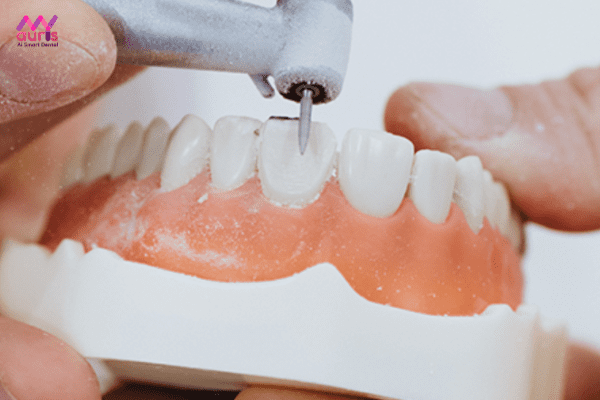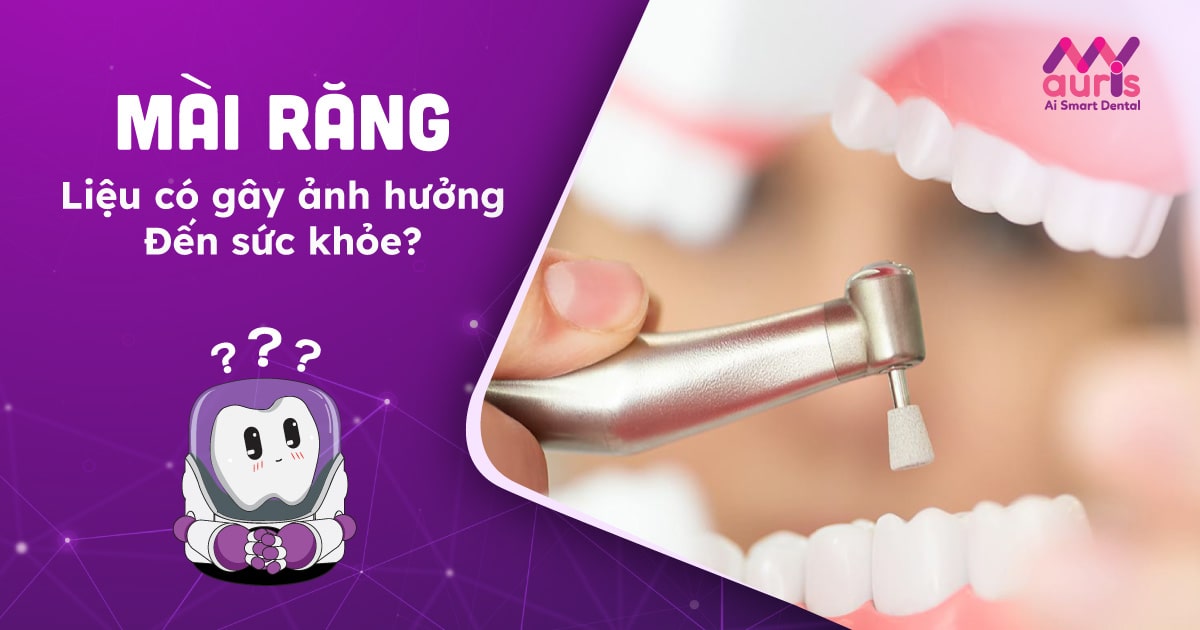Tooth preparation is a step in the porcelain crown process. This is a difficult technique that requires carefulness and meticulousness from the doctor because it will invade the tooth pulp and easily kill the pulp. So, in what cases should tooth grinding be applied and what is the grinding process like? Does it hurt? What requirements need to be met? And how much money? To answer these questions, let’s find out through the article below!
1. What is tooth base grinding?
Tooth base grinding is grinding down the real tooth, in a ratio suitable to the original tooth to create an abutment, then installing a porcelain crown so that the crown and abutment fit closely together, creating a new porcelain tooth, with the same aesthetics and chewing function as a real tooth.

The tooth grinding technique is complex, requiring the doctor to use it. Specialized tools to perform, operations need to be meticulous, very careful, both ensuring the removal of damage to the tooth crown, gums, soft tissue… while also helping the tooth pulp to be more beautiful and convenient when covering teeth with porcelain.
2. In what cases is tooth grinding used?
Normally, the doctor will prescribe tooth grinding for the following cases: buck teeth, buck teeth, teeth with uneven length or sharpness, crooked teeth,…
Because tooth grinding will cause invasion of real teeth, part of the tooth enamel will be damaged. wear and tear, causing loss of enamel on the outside of the tooth crown. Therefore, if you grind your teeth at the wrong rate, it will cause pain and sharpness when stimulated by foods that are too hot or too cold. Therefore, customers with buck teeth or teeth that are too large should not have their teeth ground down so that the dentin and enamel are protected.
If there is a need for porcelain crowns, the teeth must definitely be ground down to create a tooth base that matches the crown.
Tooth base grinding also serves the purpose of making porcelain teeth as strong as real teeth to take on the chewing function. as usual.
Tooth grinding is a difficult technique, requiring the doctor to perform it in an orderly, precise manner… avoiding encroachment on real teeth and soft tissues and gums around the tooth position to be treated.
3. Teeth grinding process
There are many different grinding methods and techniques. To create a beautiful tooth preparation model, the doctor usually goes through the following steps:
-
Use a dental blade to cut between the teeth that need grinding
-
Use a machine to cut horizontal lines on the tooth preparation for the purpose of determining the thickness.i grind teeth.
-
Brush teeth in order: chewing surface first, then outer, lateral and inner surfaces according to the determined ratio.
-
Use a drill to grind the tooth base to create a finishing line.
-
Edit the edges and round the corners of the tooth base.

4. Requirements when grinding teeth
When grinding teeth, it is necessary to ensure the following requirements:
- Do not encroach too much on real teeth, grinding should not exceed 2mm, depending on the type of tooth and method of making porcelain teeth.
- If teeth are ground too much, it will cause sensitivity, easily causing damage. damaged or broken teeth, making it easy for bacteria to attack and damage the dental pulp.
- Ensure a standard bite when installing porcelain teeth and create hardness when restoring.
- It is necessary to ensure the chewing surface area and length of the tooth crown.
- The real tooth pulp after grinding must be hard to avoid bending and breaking.
- Normally, dental crowns Metal ceramics will have to be ground more than all-ceramic porcelain teeth (about 0.2mm) because metal-ceramic crowns have a thicker structure.
- The finishing line (intersection line between the real tooth base and the porcelain crown) is the ridge connected to the ceramic crown and about 5mm away from the gums, which must ensure 3 factors: thickness, position and condition.
- During the process of tooth base grinding, absolutely no intrusion is allowed. to surrounding periodontal tissues such as gums, nerves, blood vessels… to limit the impact on neighboring teeth.
5. Does grinding teeth with porcelain crowns have any effect?
Whether grinding teeth has any effect on oral health will depend on the level and technique of the doctor. Because if grinding without proper technique will cause tooth damage, pulpitis, early tooth loss or looseness…
In fact, there are doctors who still prescribe porcelain crowns for patients with severe overbite, underbite… This results in having to grind away too many real teeth, leading to serious damage to the teeth.
To avoid unfortunate consequences when getting porcelain crowns, before doing so, you should go to a reputable dentist to have your teeth grinded according to technical standards by a qualified and skilled doctor because if the tooth grinding is calculated at a reasonable rate and done with proper technique, the porcelain crown grinding procedure will not cause harm to the teeth. teeth.
6. Is teeth grinding painful?
Because it is a direct operation that affects tooth enamel, when grinding porcelain-covered teeth, you willFeeling uncomfortable when grinding teeth. However, before grinding teeth, the doctor will administer anesthesia to make the teeth grinding process more comfortable.
7. How much does it cost to grind teeth?
How much does it cost to grind teeth with porcelain crowns will depend on the condition of the tooth and the level of pulp grinding, the price of tooth grinding will be different.
In cases where the front teeth are protruding a lot, large in size… the cost of grinding the front teeth covered with porcelain will be higher than other cases. other.
If you grind your teeth without protective measures, your teeth will be vulnerable to damage, so when grinding your teeth, you should combine porcelain coating to protect your teeth. Therefore, the price of tooth grinding depends on the quantity and type of porcelain crowns you choose. At dental offices, the cost of tooth grinding will be calculated together with the porcelain tooth restoration.
8. Porcelain crowns do not require grinding
Previously, with traditional porcelain crown techniques, real teeth would have to be ground down to fit porcelain crowns, but not exceeding 2mm. However, if done incorrectly, it will violate the internal tooth tissue, causing damage, pain and affecting the longevity of the real tooth pulp. Therefore, the non-grinding ceramic coating technique was born (only requiring 0.5 mm – 0.8 mm grinding) which has helped completely overcome the above shortcomings. With this tooth grinding rate, it will not cause any invasiveness, you can have even, harmonious teeth without having to grind your teeth too much.

In addition, to achieve high efficiency and safety in the process of grinding tooth stumps to restore porcelain teeth, you should find a reputable, quality dental center or clinic to be examined, consulted and grind tooth stumps accurately, suitable for the tooth condition. and your wishes!





